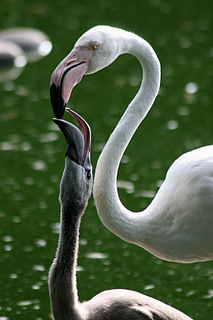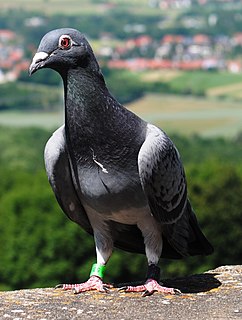 W
WThe domestic pigeon is a pigeon subspecies that was derived from the rock dove. The rock pigeon is the world's oldest domesticated bird. Mesopotamian cuneiform tablets mention the domestication of pigeons more than 5,000 years ago, as do Egyptian hieroglyphics. Research suggests that domestication of pigeons occurred as early as 10,000 years ago.
 W
WCrop milk is a secretion from the lining of the crop of parent birds that is regurgitated to young birds. It is found among all pigeons and doves where it is referred to as pigeon milk. An analog to crop milk is also secreted from the esophagus of flamingos and the male emperor penguin.
 W
WA dovecote or dovecot, doocot (Scots) or columbarium is a structure intended to house pigeons or doves. Dovecotes may be free-standing structures in a variety of shapes, or built into the end of a house or barn. They generally contain pigeonholes for the birds to nest. Pigeons and doves were an important food source historically in the Middle East and Europe and were kept for their eggs and dung.
 W
WThe Fantail is a popular breed of fancy pigeon. It is characterised by a fan-shaped tail composed of 30 to 40 feathers, abnormally more than most members of the pigeon family, which usually have 12 to 14 feathers. The breed is thought to have originated in Pakistan, India, China, Japan or Spain. There are several subvarieties, such as the English Fantail, the Indian Fantail, and the Thai Fantail. Charles Darwin used it as one of the examples in the first chapter of On The Origin Of Species. He believed it was a descendant of the rock pigeon.
 W
WThe true messenger pigeon is a variety of domestic pigeons derived from the wild rock dove, selectively bred for its ability to find its way home over extremely long distances. The rock dove has an innate homing ability, meaning that it will generally return to its nest using magnetoreception. Flights as long as 1,800 km have been recorded by birds in competitive pigeon racing. Their average flying speed over moderate 965 km distances is around 97 km/h and speeds of up to 160 km/h have been observed in top racers for short distances.
 W
WIn computer networking, IP over Avian Carriers (IPoAC) is a proposal to carry Internet Protocol (IP) traffic by birds such as homing pigeons. IP over Avian Carriers was initially described in RFC 1149, a Request for Comments (RFC) issued by the Internet Engineering Task Force (IETF), written by D. Waitzman, and released on April 1, 1990. It is one of several April Fools' Day Request for Comments.
 W
WPigeon keeping or pigeon fancying is the art and science of breeding domestic pigeons. People have practised pigeon keeping for about 10,000 years in almost every part of the world. In that time, humans have substantially altered the morphology and the behaviour of the domesticated descendants of the rock dove to suit their needs for food, aesthetic satisfaction and entertainment.
 W
WPigeon post is the use of homing pigeons to carry messages. Pigeons were effective as messengers due to their natural homing abilities. The pigeons were transported to a destination in cages, where they would be attached with messages, then the pigeon would naturally fly back to its home where the recipient could read the message. They have been used in many places around the world. Pigeons have also been used to great effect in military situations, and are in this case referred to as war pigeon.
 W
WThe Pouter pigeons are domesticated varieties of the rock dove, Columba livia, characterized by a very large, inflatable crop. They are kept as ornamental or fancy breeds, valued for their unusual appearance. There are many varieties of pouter with little in common except for the nature of the crop. The origin of the breed group is unknown, but Pouters have been bred in Europe for at least 400 years.
 W
WA Racing Homer is a breed of domestic pigeon that has been selectively bred for more speed and enhanced homing instinct for the sport of pigeon racing. A popular domestic pigeon breed, the Racing Homer is also one of the newest.
 W
WA release dove, also called a white pigeon, is a domestic rock dove bred for small size and white coloration that is released during events, such as public ceremonies, weddings and funerals.
 W
WA roller pigeon is a domesticated breed or variety of pigeon that has been selected for its ability to tumble or roll in the air. Varieties of roller pigeons include:Birmingham Roller Galatz Roller Oriental Roller Parlor Roller
The Royal Pigeon Racing Association (RPRA) is a governing body for pigeon racing in the United Kingdom. Queen Elizabeth II is the president of the RPRA and also an enthusiastic pigeon fancier herself. The RPRA has 21,000 members spread across 1,500 pigeon clubs in the UK. The association performs charity work and raises approximately £100,000 for charitable causes each year.
 W
WIn culinary terminology, squab is a young domestic pigeon, typically under four weeks old, or its meat. The meat is widely described as tasting like dark chicken. The term is probably of Scandinavian origin; the Swedish word skvabb means "loose, fat flesh". It formerly applied to all dove and pigeon species, such as the wood pigeon, the mourning dove, the extinct-in-the-wild socorro dove, and the now-extinct passenger pigeon, and their meat. More recently, squab meat comes almost entirely from domesticated pigeons. The meat of dove and pigeon gamebirds hunted primarily for sport is rarely called squab.
 W
WThe Trumpeter breeds of fancy pigeon are so named because of their unique vocalizations which sound vaguely like low laughter. Wendell Levi describes this trumpeting vocalization in his book The Pigeon. There are several domesticated varieties that possess this "trumpeting" ability to various degrees. Some of the more popular are:
 W
WTumbler pigeons are varieties of domesticated pigeons descendant from the rock dove that have been selected for their ability to tumble or roll over backwards in flight.
 W
WThe United States Army Pigeon Service was a unit of the United States Army during World War I and World War II. Their assignment was the training and usage of homing pigeons for communication and reconnaissance purposes.
 W
WUtility pigeons are domesticated pigeons bred to be a source of meat called squab. Squabs have been used as a food in many nations for centuries. They were bred to breed and grow quickly. Because they are bred for squab production, conformation to a show standard is usually deemed unimportant.
 W
WHoming pigeons have long played an important role in war. Due to their homing ability, speed and altitude, they were often used as military messengers. Carrier pigeons of the Racing Homer breed were used to carry messages in World War I and World War II, and 32 such pigeons were presented with the Dickin Medal. They ceased being used as of 1957.